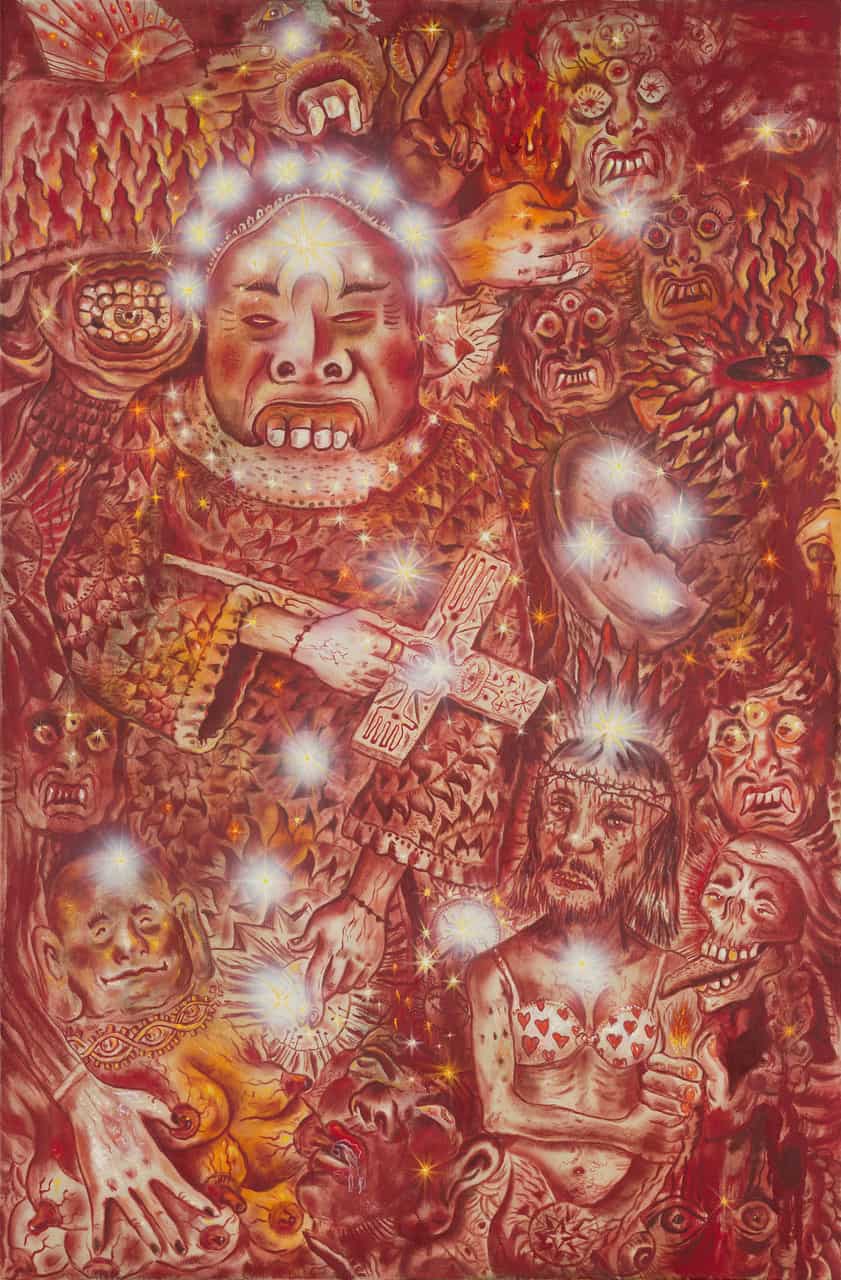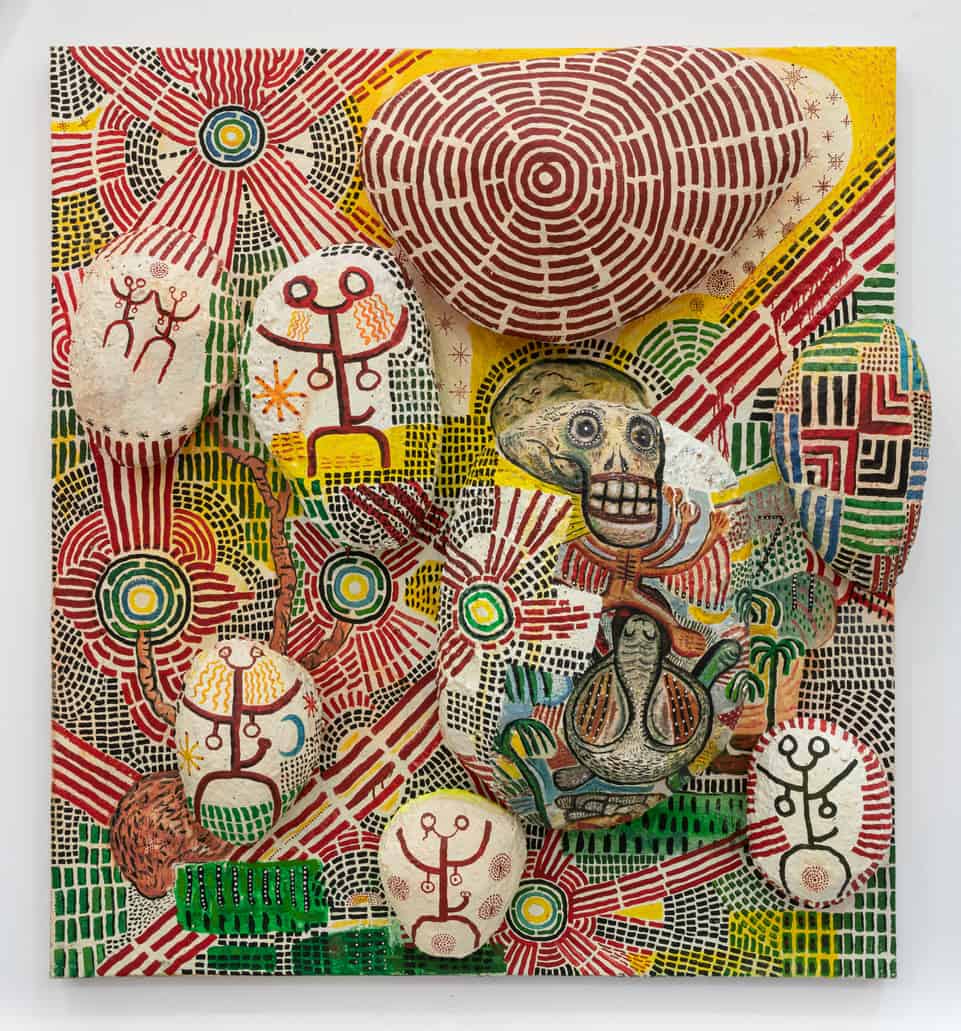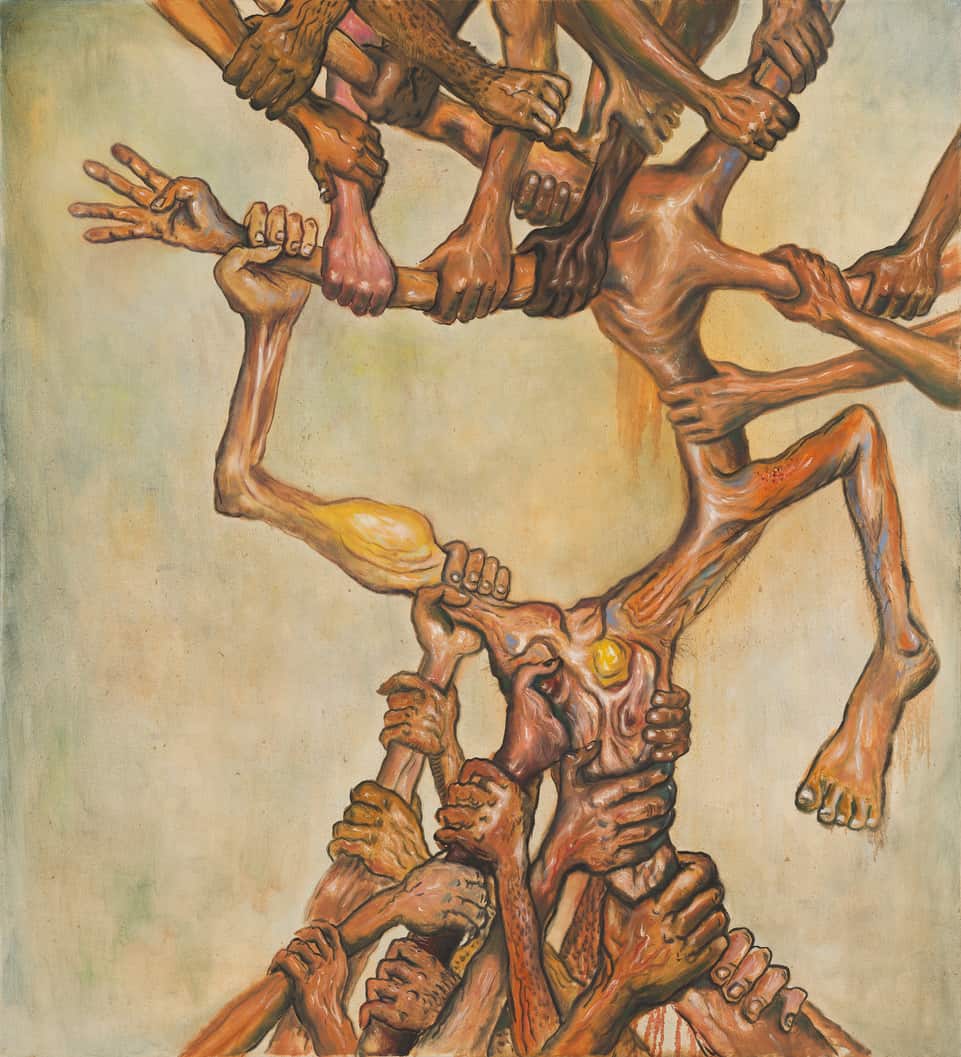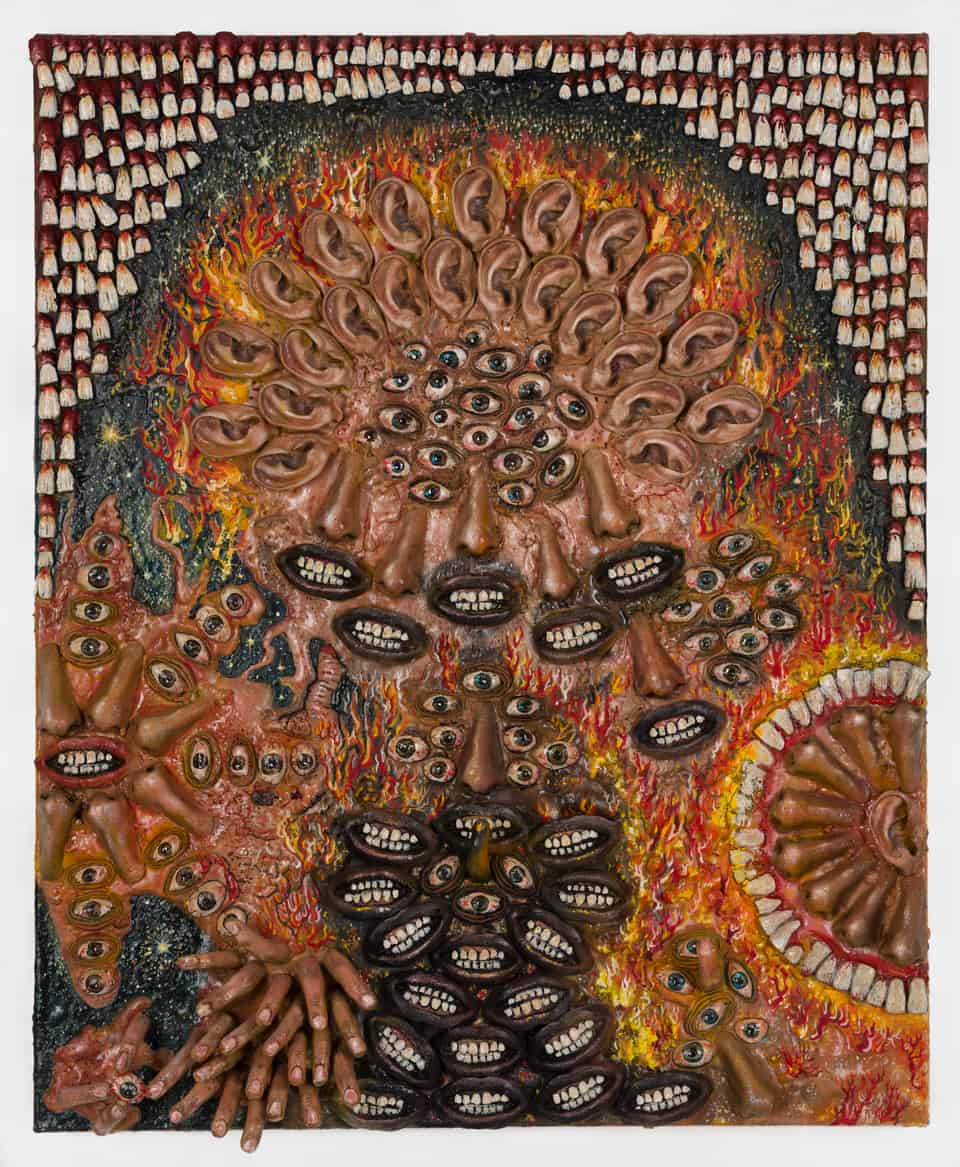Jakub Julian Ziółkowski’s intricate paintings and painting-based installations embody his personal microcosm of unsettling visions. They overflow with grotesque characters, hybrid landscapes and enigmatic events. The Polish artist invites viewers to enter his visceral, emotional worlds where obsession, fear, pleasure, and pensiveness collide unceasingly.
Partly dream-like, partly nightmarish imagery of Ziółkowski had the art world abuzz already. His oeuvre attracted the notice of prestigious galleries and museums such as Hauser&Wirth, Zachęta National Gallery of Art in Warsaw and Centre d’Art Contemporain in Geneva, among others. The well-renowned artist is now the jury member of the Allegro Prize Competition that gives the new generation of talented artists the chance to be recognized.
In the following conversation Jakub Julian Ziółkowski shares thoughts on his own artistic practice, the relationship with the art world, and what being a judge of the Allegro Prize Competition means to him.

photo Si On
Wojciech Delikta: Your painting has been described frequently as the microcosm, domain of dreams, fantastical landscape, phantasmagoria and the kingdom of chaos in which you – as the demiurge – restore the order. What are you looking for in these surreal universes?
Jakub Julian Ziółkowski: Art is a tool for understanding, going beyond and learning about the self. Artistic practice is a state of mind, in other words a state of “internal traveling.” Engrossed in the process of a journey itself, you no longer care what you’re looking for because you happen to stumble on things automatically.
Artistic practice represents our internal dimension, this depth you descend into to bridge the divide between the world on the outside and on the inside; to synchronize the import and export of energy and information. The artistic tool knows no bounds. In my opinion, if an artist is looking for anything, then it could only be the best way to attain this state of mind.
WD: Some viewers claim that these worlds you create are completely detached from the reality, which we’re all familiar with. Is their assumption correct?
JJZ: It’s more like the artist inserts an alternative reality as a counterpart to the reality already established as a way of interpreting it. Both worlds are interconnected, one can’t exist without the other. Everything is an interpretation. I’m more inclined to say that the reality is like a boomerang that circles back to you in the form of a work of art. Everything I need is already here, and it always has been, as I reach for the material and start being about. All I had to do was to immerse myself in this state, freefall, tune out the judgmental thought-policing in my head blocking my creative energy. You get in touch with yourself on deep and multiple levels, looking inwards, but it has nothing to do with being detached from reality.
I don’t own a TV, I never listen to the radio, though I have a garden and a porch, where I love to sit and stare into the distance, at the sky and trees. Perhaps, this sort of lifestyle represents one’s “detachment from reality which we’re all familiar with” in Poland.

Jakub Julian Ziółkowski, Liberate Te Ex Infernis, 2017, 68 x 57 cm, oil on panel, courtesy of the artist
WD: Is there any connection between your past statement that painting helps “air one’s thoughts” with the oversaturation of components on you canvases?
JJZ: These are two entirely separate issues. The multiplicity of elements arises from my predilection for life, vibrancy and motion in art. I wish for the viewers to absorb a piece, sink deeper into it, discern hidden details, connect the dots and read a painting like a novel. Airing one’s thoughts is another matter altogether. We live in the merciless, primitive world plagued by injustice. Sensitive and creative individuals seem to choke on this unpalatable world, knowing no rest, so they have to examine the guts, physically clear the airway, conduct an analysis, retrieve a piece, pull it out into the open and show it to the world. Such a creative exploration of the world carries immense power.
WD: Apart from the borderline obsessive horror vacui on your canvas, there’s also the art installation titled “Imagorea” (2014), which brings to mind the visualization of a compulsive hoarding disorder. Could you please share with us the story behind this project?
JJZ: Contrary to your conjecture, Imagorea is a meticulously considered, calculated and painstakingly executed installation that I was working on for an entire year, day by day, from morning into the night. Imagorea is the wooden structure filled with 192 paintings. The outside world is visible through the openings between the canvases, while the inside is inundated with paintings. This piece has an introspective nature, maps out my own state of mind, my stream of consciousness. Paramount to the creative process were regular meetings in my art studio with Bartłomiej Dobroczyński, a professor of psychology and my great friend, who wrote an essay about Imagorea. I believe it’s the first accurate interpretation of my artistic practice.
In retrospect, I’m under the impression that I had this need to burn out the excess of energy, experience what it means to teether at the edge of a void, drained, move on past a certain chapter in my life.

Jakub Julian Ziółkowski, Temple of them all_Świątynia Ich Wszystkich, 2019, oil on canvas, 95 x 145cm, photo by Mateusz Torbus, courtesy of the artist
WD: At some point, you abandoned painting and headed to Vietnam. Why did you decide to take a break from the medium and what were the results of this decision?
JJZ: Sometimes you just need to take a breather, invest in change, swim against the tide even if you happen to be right at the top of your game. It’s every artist’s secret: where and how does he/she draw the energy for work.
One day I decided to leave my studio and go outside, open up to collaborating with strangers, not necessarily fellow artists. Every now and then, you have to break the habit, adjust the way you operate, reorganize your materials and tools. This year-long journey was my own personal quest.
In Hanoi, I presented a series of paper sculptures, which I then burned ritualistically. Gigantic painted ceramic vases, lots of experimental pieces, videos and so on, also came into existence. It was the time of tranquility, isolation, meditation and reflection. Three exhibitions channeled this energy: “Ian Moon” at the London-based Hauser&Wirth, “Holy Nothing” at the Centre of Contemporary Art Ujazdowski Castle in Warsaw, which I prepared alongside Si On, my wife and an extraordinary Korean artist. The third art show entitled “Nasellini” took place in the Man Museum in Sardinia. This enigmatic project revolved around the fictional pasta – audience was induced into an eerie state of mind upon its consumption. Although I was invited to stage a fairly conventional exhibition of paintings, I ended up collaborating with the entire community of Nuoro; obviously it was the local restaurant that cooked the pasta for the exhibition opening. The whole town showed up to the opening to check out this Nasellini.
WD: Religious imagery, enigmatic symbols, iconography and motifs from the Far East, references to the shamanistic rituals are all embedded permanently in your visual language. Would you, following the critics, describe your art as metaphysical?
JJZ: Albeit its constant evolution, the core of my work stays the same, namely an examination of reality, what is what, why is that so, who am I, where am I, why am I, and so on. It’s possible my work has become more mystical, contemplative, metaphysical, more abstract in the last couple of years, but it’s exactly how it’s supposed to be, it’s the right direction.

Jakub Julian Ziółkowski, The Origin of Man, 2020, 108 x 98 cm, oil and mixed media on canvas, courtesy of the artist
WD: Is the current condition of the art market any different from the times when you were starting our as an artist?
JJZ: There’s this story about a race dog that had won all competitions until one day the dog jumped through the railing, ran across the stadium and caught the bunny instead of just chasing it. So did it win or lose the race? Well, it definitively spoiled the enjoyment of those smoking cigars and placing bets in the audience.
Artists feel greatly appreciated when they’re welcomed to the art market like kings. Soon enough, it turns out they are only pieces of the puzzle. The art market as such is neutral, the issue lies in the deceiving intentions and greed of galleries, collectors as well as artists themselves.
Personally, I believe that those judging the artists today in accordance with categories of loss and profit used to have slightly bigger plans and ambitions fifteen years ago, when I joined the scene. Nowadays, a prompt return on investment is expected. Wall Street swallowed the Artworld and degraded depth to races. The emerging galleries are less daring than they used to be, and if they do display some bravado, they tend to close up shop pretty quickly or pivot into more commercial activity. Finding the middle ground seems more and more complicated these days.
WD: An inclusive nature of Allegro Prize Competition 2020 allows any artist to send their submission regardless of their artistic experience and discipline. The organizers have also decided against charging any entrance fee, so the competition is free for all. It’s not your debut as a jury member. What does it mean to you as an artist to view and evaluate the works of others in this type of competition?
JJZ: I was a jury member of the Deste Art Prize competition held in Athens, in which the prize is funded by Dakis Joannou, one of the most prominent contemporary art collectors in the world. Meanwhile in this case we take digital portfolios under consideration, bear in mind pictures on the computer screen distort one’s perception. I’m extremely curious to find out what will the artists submit. I hope to be surprised. Lately, I’ve had this desolate impression that increasingly less things are capable of bringing me delight. I’m not sure if it’s just a side effect of approaching middle age or if the ubiquitous instances of reproducing, copying and imitating others have banished the potential for the unexpected in the art world. These days surprises are few and far in-between.

Jakub Julian Ziółkowski, Society_Społeczeństwo, 2019, 97 x 108cm, oil on canvas, photo by Mateusz Torbus, courtesy of the artist
WD: Have you specified your assessment criteria?
JJZ: Not really, there are no rules in art, no assessment criteria. Art is always of the utmost importance regardless of who, where and how. The art world has this weird obsession about the resume providing information about who shows their work where, who runs what gallery and what market position do they occupy. I’m not interested in following this train of thought in the slightest. What’s quintessential here is art, vision, energy and beams of personality emanating from a piece.
Jakub Julian Ziółkowski “Krauser”, 2019, 82×66 cm, oil and mixed media on canvas










